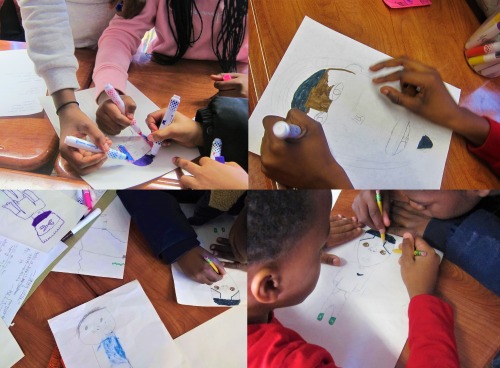We told the students that today’s session is very important because they are going to create the “soul” of their puppet. It’s an abstract concept but through a series of story telling, writing, and drawing activities a personality starts to take shape. The goal is to create a unique character that represents pieces of everyone in the group. Like all of our sessions it starts with a game.
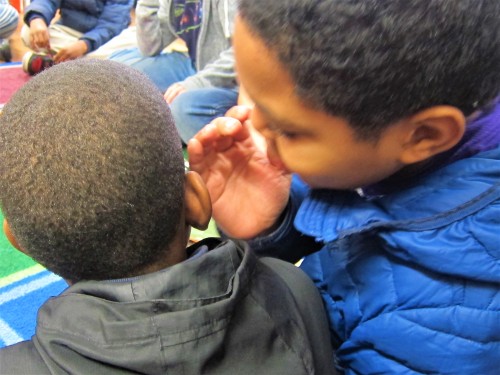
A student whispering to his classmate
Most of the students are familiar with “Telephone” or “Whisper Down the Lane.” They sit in a circle, and the first person whispers a phrase to the person next to them. That person turns and whispers what they hear to the next person. The phrase is passed along until the last person says what they heard out loud. We started with this activity to practice active listening skills and talk about how art and messages can change over time. The phrase “Hold fast to dreams” from a Langston Hughes poem was the first phrase. By the time it got around the circle the result was “Breakfast is mine!” This elicited a round of laughter. We pointed out that both phrases contain the word “fast,” are four syllables long, and can be chanted during our puppet parade.
Jennifer Turnbull introducing “Story Circles”
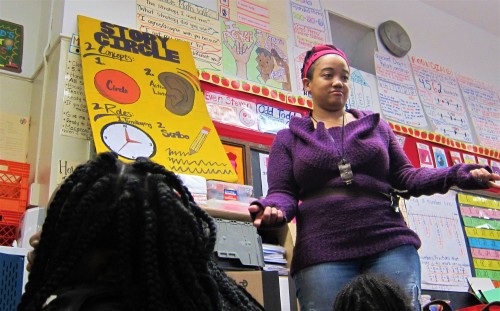
Jennifer Turnbull, the co-director of Spiral Q, paid the class a surprise visit and introduced the concept of story circles. She pointed out how the technique was used by writers and activists during the Harlem Renaissance, the Civil Rights movement, and modern day activists. Everybody has a right to tell their story and everybody deserves to have their story be heard. When she asked, “Why is sitting in the shape of the circle important?” students didn’t miss a beat. “Because everyone is equal.” “Because there is no beginning and no end.” “So everyone can look at each other.” We ask them to raise their hands and wait to be called on so everyone can hear their answer but sometimes they get so excited their wisdom just jumps out of their mouths!
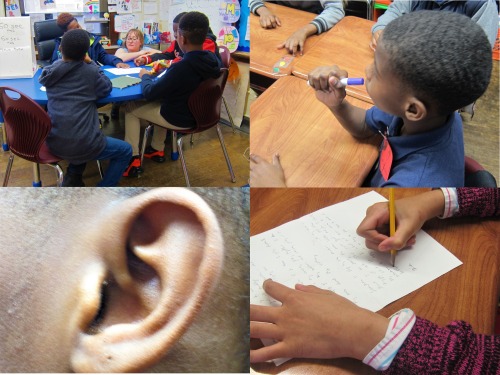
Ms. Alexis facilitating a story circle, a student demonstrating “one mic,” a listening ear, a student taking notes for “snapshots.” (Photos by students)
Once students were sitting in their small groups they each had one minute to talk without interruption. They were asked to tell a story, in as much detail as possible, about a time they felt a strong emotion from a work of art. They talked about movies, songs, dance videos, paintings, and even a roller coaster. If someone stopped before their time was up other students encouraged them to continue by saying, “Tell us more details,” and asking, “How did it make you feel?” The next step in the process “Snapshots” had each student pointing out what they heard or felt a connection to while listening to their peers. This is where commonalities start to come to light. One student pointed out how everyone in his group told stories about being with family. Another pointed out how each story in her group took place at a school. These themes were further explored during the “cross talk” portion where students informally ask questions and make comments.

Collaborative drawing and character sketches
The final activity of the day involves turning the themes and shared experiences into a character. Each group has to write down background information inspired by their conversations. For example, the group that noticed their stories all took place at school created a young student who likes to study. To answer the question, “What does your character to do improve their world?” they decided she uses her education to make speeches and is politically active. Other groups answered that question with a young man who invents technology to clean up the ocean and a mother who uses animation to spread messages of peace.
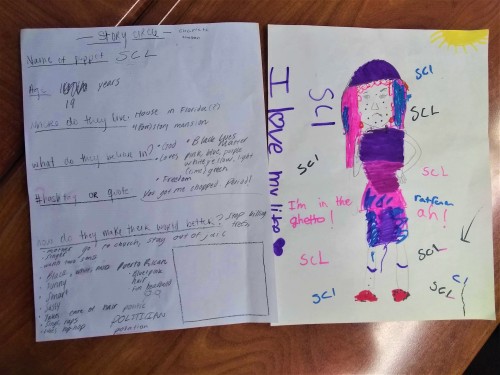
“SCL” a 19 year old Black/White/Puerto Rican girl from Florida who believes in Black Lives Matter, God, and freedom. She is a singing, rapping, environmental politician
One of the goals of group work is to teach students how to resolve conflict and make consensus based decisions. A great example of this happened in one group when they were answering the question, “What does your character believe in?” One student said, “God and Jesus,” and two other students nodded in agreement. However, one girl said, “No.” Rather than scrapping the whole idea of a character being religious this student was asked, “Tell us what you are thinking.” She said she is Muslim and believes in Allah but not Jesus. With guidance the group agreed that they could make a Muslim character, so everyone could feel included knowing that Allah is the Islamic name for “God.” Also, another group in the class was working on a Christian character. Everyone felt satisfied that their would be represented in the project, even if it wasn’t in their particular puppet. Then they talked about the features that would show that the character was Muslim. Since it was a 20 year old man, he would have a short beard, mustache, and would wear a kufi head covering. These are the types of characters and stories that we can’t predict. This depth of character and symbolism can only come from the unexpected results of collaboration.

